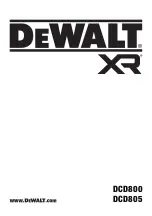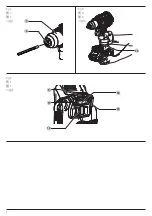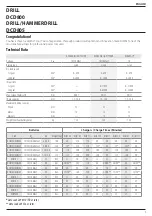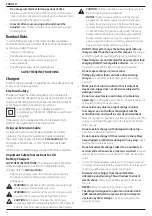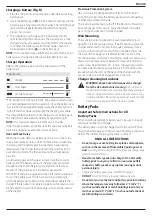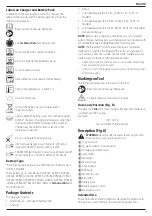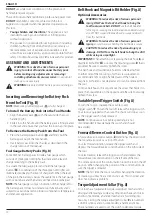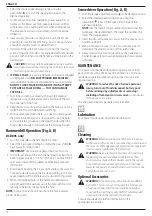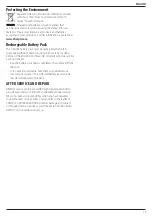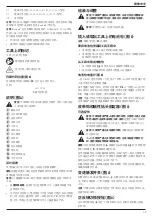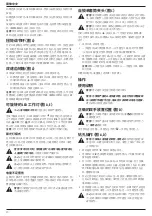
12
English
2. Select the desired speed/torque range using the
gear shifter
4
to match the speed and torque to the
planned operation.
3. For Wood, use twist bits, spade bits, power auger bits or
hole saws. For Metal, use high‑speed steel twist drill bits
or hole saws. Use a cutting lubricant when drilling metals.
The exceptions are cast iron and brass which should be
drilled dry.
4. Always apply pressure in a straight line with the bit. Use
enough pressure to keep drill biting, but do not push hard
enough to stall the motor or deflect the bit.
5. Hold tool firmly with both hands to control the twisting
action of the drill. If model is not equipped with side handle,
grip drill with one hand on the handle and one hand on the
battery pack.
CAUTION:
Drill may stall if overloaded causing a sudden
twist. Always expect the stall. Grip the drill firmly to control
the twisting action and avoid injury.
6.
iF DRill sTAlls,
it is usually because it is being overloaded
or improperly used.
RElEAsE TRiggER iMMEDiATElY,
remove drill bit from work, and determine cause of stalling.
DO nOT CliCK TRiggER On AnD OFF in An ATTEMPT
TO sTART A sTAllED DRill — This CAn DAMAgE
ThE DRill.
7. To minimise stalling or breaking through the material,
reduce pressure on drill and ease the bit through the last
fractional part of the hole.
8. Keep the motor running when pulling the bit back out of a
drilled hole. This will help prevent jamming.
9. With variable speed drills there is no need to centre punch
the point to be drilled. Use a slow speed to start the hole
and accelerate by squeezing the trigger harder when the
hole is deep enough to drill without the bit skipping out.
Hammerdrill Operation (Fig. A, D)
DCD805 only
1. Turn the collar
3
to the hammerdrill symbol.
2. Select the high speed setting by sliding the gear shifter
4
back (away from the chuck).
iMPORTAnT:
Use carbide‑tipped or masonry bits only.
3. Drill with just enough force on the hammer to keep it from
bouncing excessively or “rising” off the bit. Too much force
will cause slower drilling speeds, overheating and lower
drilling rate.
4. Drill straight, keeping the bit at a right angle to the work. Do
not exert side pressure on the bit when drillling as this will
cause clogging of the bit flutes and a slower drilling speed.
5. When drilling deep holes, if the hammer speed starts to
drop off, pull the bit partially out of the hole with tool still
running to help clear debris from the hole.
nOTE:
A smooth, even flow of dust from the hole indicates
proper drilling rate.
Screwdriver Operation (Fig. A, D)
1. Turn the torque adjustment collar
3
to the desired position.
2. Select the desired speed/torque range using the
gear shifter
4
to match the speed and torque of the
planned operation.
nOTE:
Use the lowest torque setting required to seat the
fastener at the desired depth. The lower the number, the
lower the torque output.
3. Insert the desired fastener accessory into the chuck as you
would any drill bit.
4. Make some practice runs in scrap or on unseen areas to
determine the proper position of the clutch collar.
5. Always start with lower torque settings, then advance to
higher torque settings to avoid damage to the workpiece
or fastener.
MAINTENANCE
Your power tool has been designed to operate over a long
period of time with a minimum of maintenance. Continuous
satisfactory operation depends upon proper tool care and
regular cleaning.
WARNING:
To reduce the risk of serious personal
injury, turn tool off and disconnect battery pack
before making any adjustments or removing/
installing attachments or accessories.
An accidental
start‑up can cause injury.
The charger and battery pack are not serviceable.
C
Lubrication
Your power tool requires no additional lubrication.
D
Cleaning
WARNING:
Blow dirt and dust out of the main housing
with dry air as often as dirt is seen collecting in and around
the air vents. Wear approved eye protection and approved
dust mask when performing this procedure.
WARNING:
Never use solvents or other harsh chemicals
for cleaning the non‑metallic parts of the tool. These
chemicals may weaken the materials used in these parts.
Use a cloth dampened only with water and mild soap.
Never let any liquid get inside the tool; never immerse any
part of the tool into a liquid.
Optional Accessories
WARNING:
Since accessories, other than those offered
by
D
e
WALT
, have not been tested with this product, use
of such accessories with this tool could be hazardous.
To reduce the risk of injury, only
D
e
WALT
recommended
accessories should be used with this product.
Consult your dealer for further information on the
appropriate accessories.

